Marketing Strategy and Application: Comparing Aldi and Sainsbury's
VerifiedAdded on 2024/05/16
|8
|2117
|280
Report
AI Summary
This report provides a comparative analysis of the marketing strategies employed by Aldi and Sainsbury, two prominent supermarket chains. It delves into the application of the marketing mix (Product, Price, Place, Promotion, People, Process, and Physical Evidence) by each company to achieve their respective business objectives. The report highlights Aldi's focus on affordable pricing and efficient operations, contrasting it with Sainsbury's emphasis on product quality and customer service. By examining these elements, the report illustrates how each company tailors its marketing approach to its target market and competitive landscape, providing valuable insights into the strategic considerations driving their success. The analysis covers aspects such as product sourcing, pricing strategies, store layouts, promotional activities, and customer service approaches, demonstrating the multifaceted nature of marketing strategy in the retail sector. The document concludes that the marketing mix is an effective tool that helps organisations in achieving their objectives.
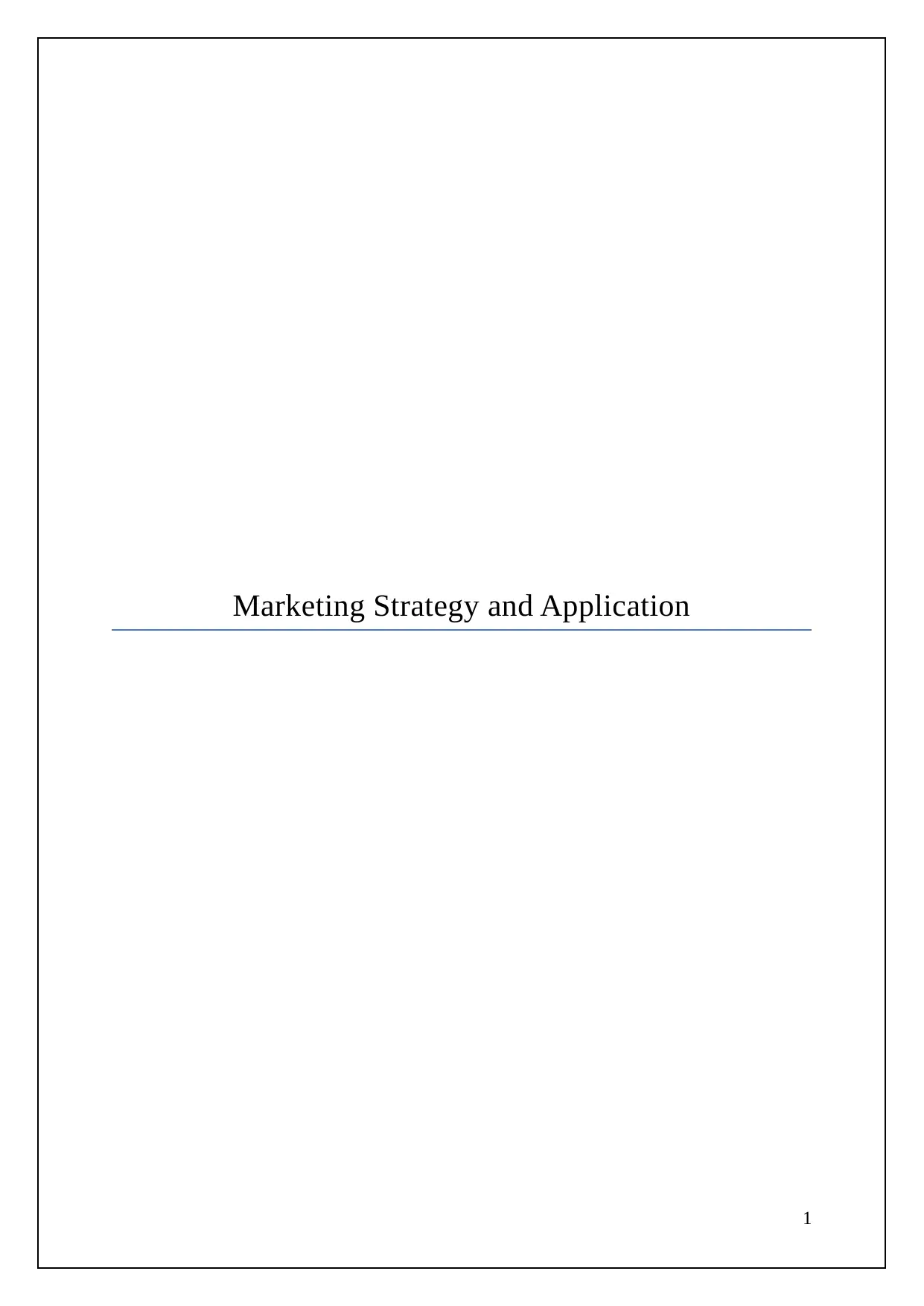
Marketing Strategy and Application
1
1
Paraphrase This Document
Need a fresh take? Get an instant paraphrase of this document with our AI Paraphraser
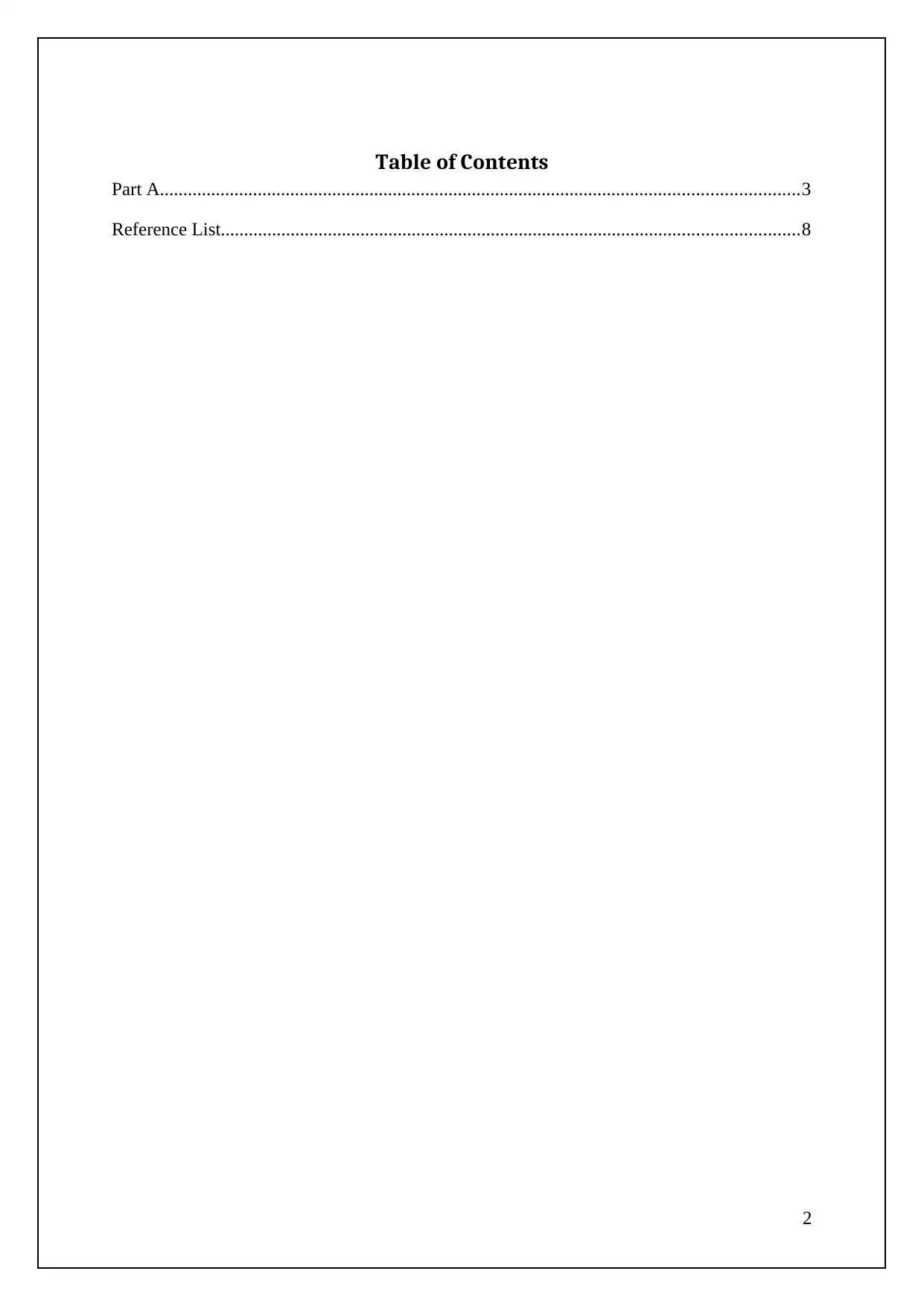
Table of Contents
Part A.........................................................................................................................................3
Reference List............................................................................................................................8
2
Part A.........................................................................................................................................3
Reference List............................................................................................................................8
2
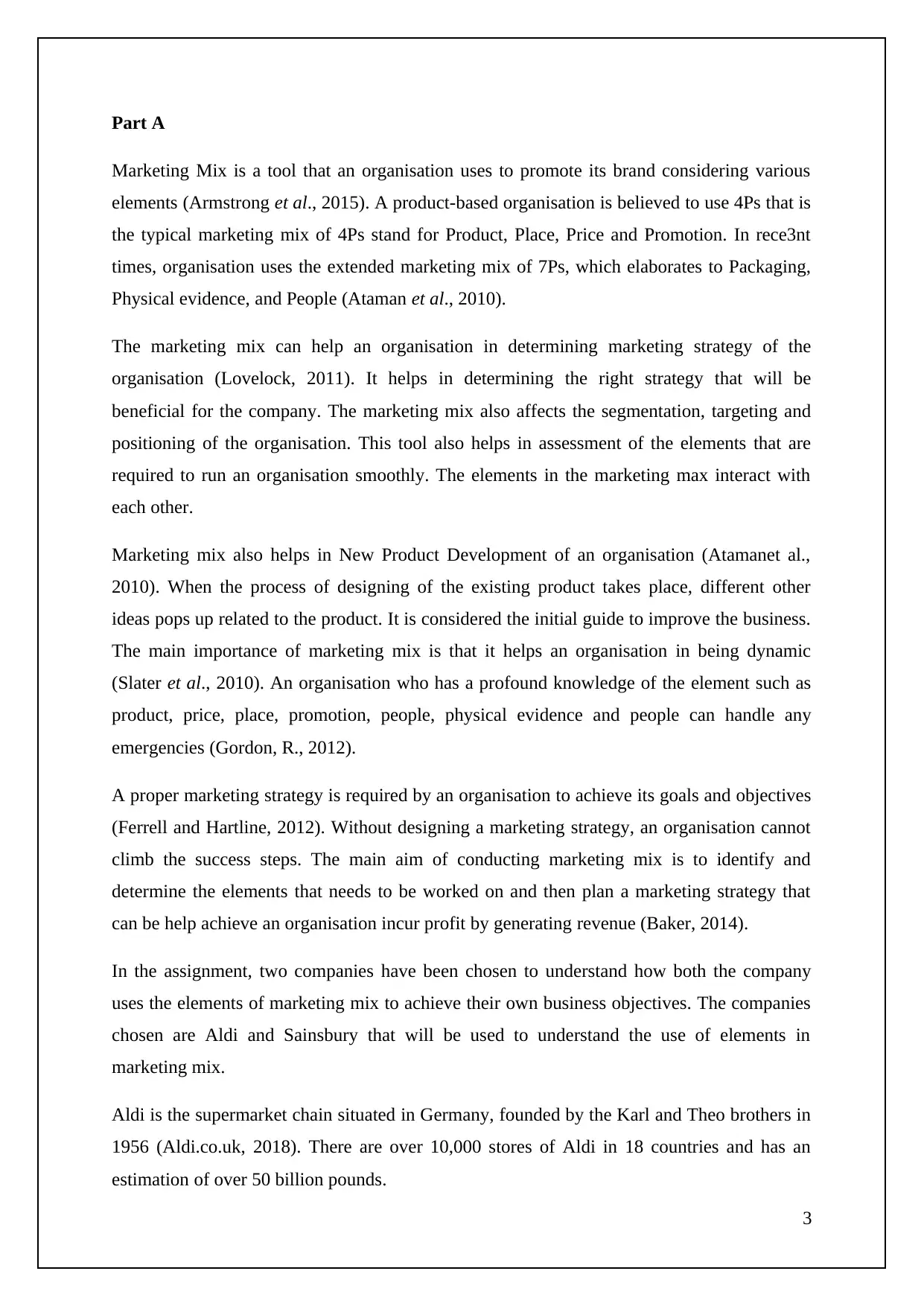
Part A
Marketing Mix is a tool that an organisation uses to promote its brand considering various
elements (Armstrong et al., 2015). A product-based organisation is believed to use 4Ps that is
the typical marketing mix of 4Ps stand for Product, Place, Price and Promotion. In rece3nt
times, organisation uses the extended marketing mix of 7Ps, which elaborates to Packaging,
Physical evidence, and People (Ataman et al., 2010).
The marketing mix can help an organisation in determining marketing strategy of the
organisation (Lovelock, 2011). It helps in determining the right strategy that will be
beneficial for the company. The marketing mix also affects the segmentation, targeting and
positioning of the organisation. This tool also helps in assessment of the elements that are
required to run an organisation smoothly. The elements in the marketing max interact with
each other.
Marketing mix also helps in New Product Development of an organisation (Atamanet al.,
2010). When the process of designing of the existing product takes place, different other
ideas pops up related to the product. It is considered the initial guide to improve the business.
The main importance of marketing mix is that it helps an organisation in being dynamic
(Slater et al., 2010). An organisation who has a profound knowledge of the element such as
product, price, place, promotion, people, physical evidence and people can handle any
emergencies (Gordon, R., 2012).
A proper marketing strategy is required by an organisation to achieve its goals and objectives
(Ferrell and Hartline, 2012). Without designing a marketing strategy, an organisation cannot
climb the success steps. The main aim of conducting marketing mix is to identify and
determine the elements that needs to be worked on and then plan a marketing strategy that
can be help achieve an organisation incur profit by generating revenue (Baker, 2014).
In the assignment, two companies have been chosen to understand how both the company
uses the elements of marketing mix to achieve their own business objectives. The companies
chosen are Aldi and Sainsbury that will be used to understand the use of elements in
marketing mix.
Aldi is the supermarket chain situated in Germany, founded by the Karl and Theo brothers in
1956 (Aldi.co.uk, 2018). There are over 10,000 stores of Aldi in 18 countries and has an
estimation of over 50 billion pounds.
3
Marketing Mix is a tool that an organisation uses to promote its brand considering various
elements (Armstrong et al., 2015). A product-based organisation is believed to use 4Ps that is
the typical marketing mix of 4Ps stand for Product, Place, Price and Promotion. In rece3nt
times, organisation uses the extended marketing mix of 7Ps, which elaborates to Packaging,
Physical evidence, and People (Ataman et al., 2010).
The marketing mix can help an organisation in determining marketing strategy of the
organisation (Lovelock, 2011). It helps in determining the right strategy that will be
beneficial for the company. The marketing mix also affects the segmentation, targeting and
positioning of the organisation. This tool also helps in assessment of the elements that are
required to run an organisation smoothly. The elements in the marketing max interact with
each other.
Marketing mix also helps in New Product Development of an organisation (Atamanet al.,
2010). When the process of designing of the existing product takes place, different other
ideas pops up related to the product. It is considered the initial guide to improve the business.
The main importance of marketing mix is that it helps an organisation in being dynamic
(Slater et al., 2010). An organisation who has a profound knowledge of the element such as
product, price, place, promotion, people, physical evidence and people can handle any
emergencies (Gordon, R., 2012).
A proper marketing strategy is required by an organisation to achieve its goals and objectives
(Ferrell and Hartline, 2012). Without designing a marketing strategy, an organisation cannot
climb the success steps. The main aim of conducting marketing mix is to identify and
determine the elements that needs to be worked on and then plan a marketing strategy that
can be help achieve an organisation incur profit by generating revenue (Baker, 2014).
In the assignment, two companies have been chosen to understand how both the company
uses the elements of marketing mix to achieve their own business objectives. The companies
chosen are Aldi and Sainsbury that will be used to understand the use of elements in
marketing mix.
Aldi is the supermarket chain situated in Germany, founded by the Karl and Theo brothers in
1956 (Aldi.co.uk, 2018). There are over 10,000 stores of Aldi in 18 countries and has an
estimation of over 50 billion pounds.
3
⊘ This is a preview!⊘
Do you want full access?
Subscribe today to unlock all pages.

Trusted by 1+ million students worldwide
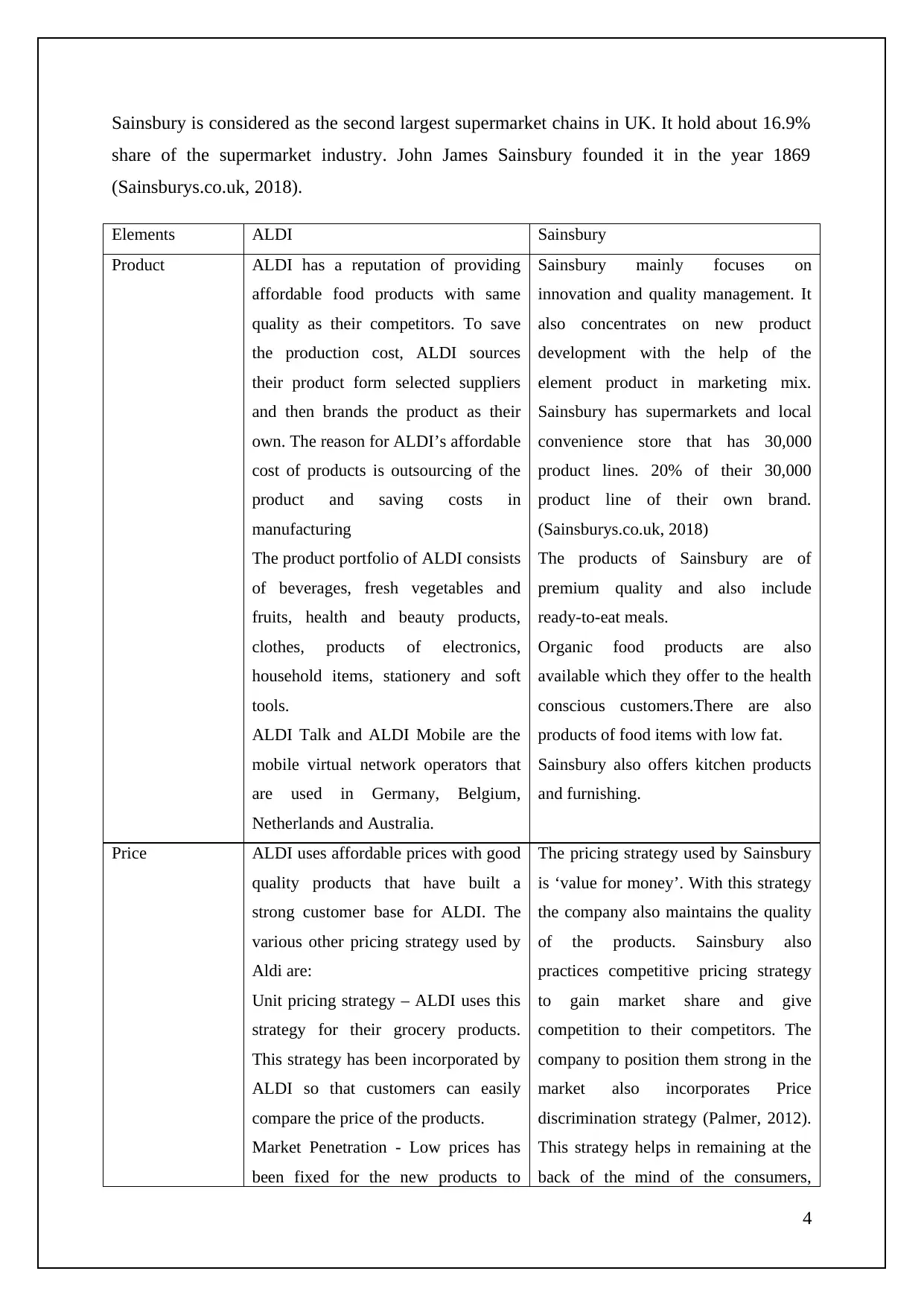
Sainsbury is considered as the second largest supermarket chains in UK. It hold about 16.9%
share of the supermarket industry. John James Sainsbury founded it in the year 1869
(Sainsburys.co.uk, 2018).
Elements ALDI Sainsbury
Product ALDI has a reputation of providing
affordable food products with same
quality as their competitors. To save
the production cost, ALDI sources
their product form selected suppliers
and then brands the product as their
own. The reason for ALDI’s affordable
cost of products is outsourcing of the
product and saving costs in
manufacturing
The product portfolio of ALDI consists
of beverages, fresh vegetables and
fruits, health and beauty products,
clothes, products of electronics,
household items, stationery and soft
tools.
ALDI Talk and ALDI Mobile are the
mobile virtual network operators that
are used in Germany, Belgium,
Netherlands and Australia.
Sainsbury mainly focuses on
innovation and quality management. It
also concentrates on new product
development with the help of the
element product in marketing mix.
Sainsbury has supermarkets and local
convenience store that has 30,000
product lines. 20% of their 30,000
product line of their own brand.
(Sainsburys.co.uk, 2018)
The products of Sainsbury are of
premium quality and also include
ready-to-eat meals.
Organic food products are also
available which they offer to the health
conscious customers.There are also
products of food items with low fat.
Sainsbury also offers kitchen products
and furnishing.
Price ALDI uses affordable prices with good
quality products that have built a
strong customer base for ALDI. The
various other pricing strategy used by
Aldi are:
Unit pricing strategy – ALDI uses this
strategy for their grocery products.
This strategy has been incorporated by
ALDI so that customers can easily
compare the price of the products.
Market Penetration - Low prices has
been fixed for the new products to
The pricing strategy used by Sainsbury
is ‘value for money’. With this strategy
the company also maintains the quality
of the products. Sainsbury also
practices competitive pricing strategy
to gain market share and give
competition to their competitors. The
company to position them strong in the
market also incorporates Price
discrimination strategy (Palmer, 2012).
This strategy helps in remaining at the
back of the mind of the consumers,
4
share of the supermarket industry. John James Sainsbury founded it in the year 1869
(Sainsburys.co.uk, 2018).
Elements ALDI Sainsbury
Product ALDI has a reputation of providing
affordable food products with same
quality as their competitors. To save
the production cost, ALDI sources
their product form selected suppliers
and then brands the product as their
own. The reason for ALDI’s affordable
cost of products is outsourcing of the
product and saving costs in
manufacturing
The product portfolio of ALDI consists
of beverages, fresh vegetables and
fruits, health and beauty products,
clothes, products of electronics,
household items, stationery and soft
tools.
ALDI Talk and ALDI Mobile are the
mobile virtual network operators that
are used in Germany, Belgium,
Netherlands and Australia.
Sainsbury mainly focuses on
innovation and quality management. It
also concentrates on new product
development with the help of the
element product in marketing mix.
Sainsbury has supermarkets and local
convenience store that has 30,000
product lines. 20% of their 30,000
product line of their own brand.
(Sainsburys.co.uk, 2018)
The products of Sainsbury are of
premium quality and also include
ready-to-eat meals.
Organic food products are also
available which they offer to the health
conscious customers.There are also
products of food items with low fat.
Sainsbury also offers kitchen products
and furnishing.
Price ALDI uses affordable prices with good
quality products that have built a
strong customer base for ALDI. The
various other pricing strategy used by
Aldi are:
Unit pricing strategy – ALDI uses this
strategy for their grocery products.
This strategy has been incorporated by
ALDI so that customers can easily
compare the price of the products.
Market Penetration - Low prices has
been fixed for the new products to
The pricing strategy used by Sainsbury
is ‘value for money’. With this strategy
the company also maintains the quality
of the products. Sainsbury also
practices competitive pricing strategy
to gain market share and give
competition to their competitors. The
company to position them strong in the
market also incorporates Price
discrimination strategy (Palmer, 2012).
This strategy helps in remaining at the
back of the mind of the consumers,
4
Paraphrase This Document
Need a fresh take? Get an instant paraphrase of this document with our AI Paraphraser
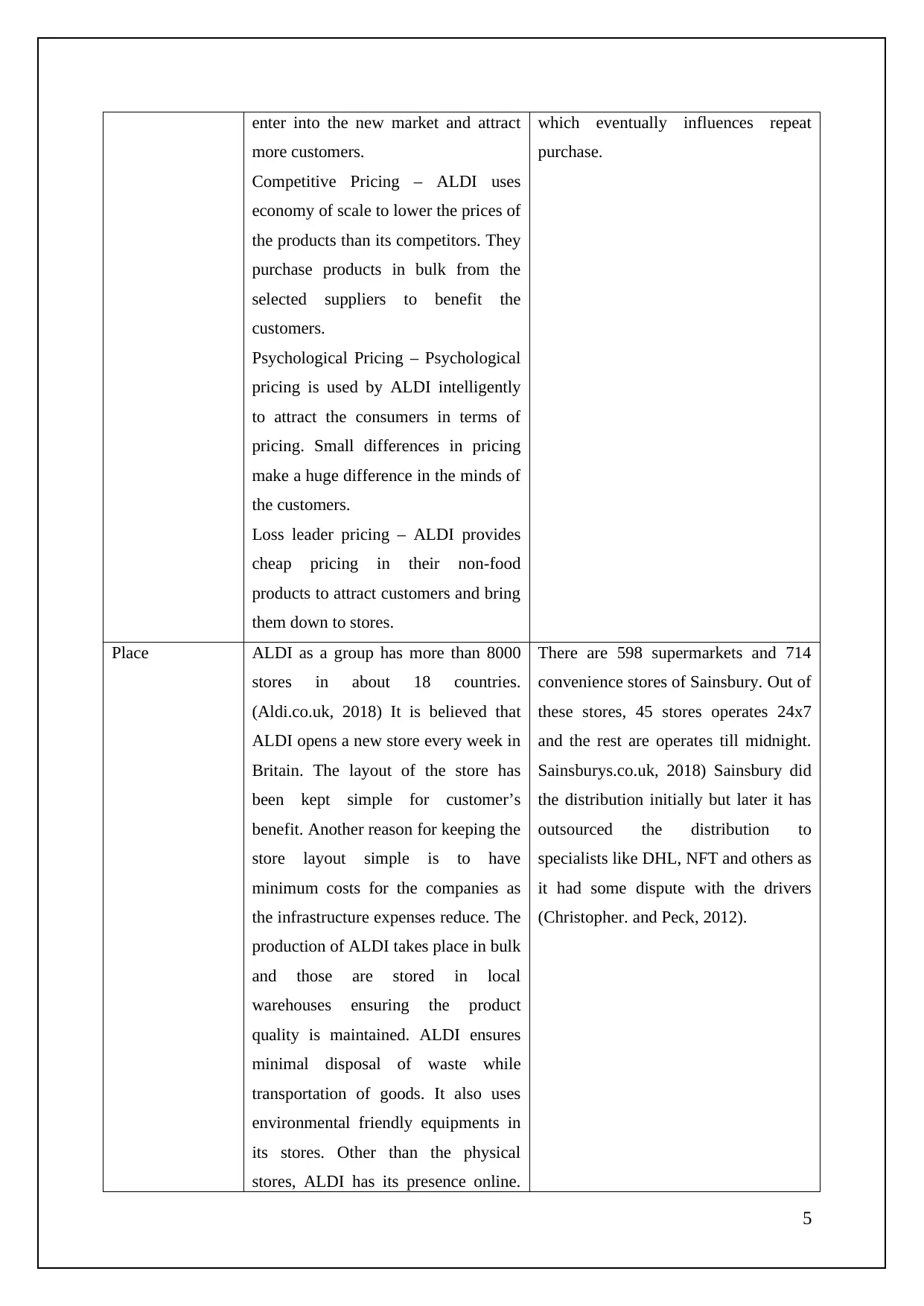
enter into the new market and attract
more customers.
Competitive Pricing – ALDI uses
economy of scale to lower the prices of
the products than its competitors. They
purchase products in bulk from the
selected suppliers to benefit the
customers.
Psychological Pricing – Psychological
pricing is used by ALDI intelligently
to attract the consumers in terms of
pricing. Small differences in pricing
make a huge difference in the minds of
the customers.
Loss leader pricing – ALDI provides
cheap pricing in their non-food
products to attract customers and bring
them down to stores.
which eventually influences repeat
purchase.
Place ALDI as a group has more than 8000
stores in about 18 countries.
(Aldi.co.uk, 2018) It is believed that
ALDI opens a new store every week in
Britain. The layout of the store has
been kept simple for customer’s
benefit. Another reason for keeping the
store layout simple is to have
minimum costs for the companies as
the infrastructure expenses reduce. The
production of ALDI takes place in bulk
and those are stored in local
warehouses ensuring the product
quality is maintained. ALDI ensures
minimal disposal of waste while
transportation of goods. It also uses
environmental friendly equipments in
its stores. Other than the physical
stores, ALDI has its presence online.
There are 598 supermarkets and 714
convenience stores of Sainsbury. Out of
these stores, 45 stores operates 24x7
and the rest are operates till midnight.
Sainsburys.co.uk, 2018) Sainsbury did
the distribution initially but later it has
outsourced the distribution to
specialists like DHL, NFT and others as
it had some dispute with the drivers
(Christopher. and Peck, 2012).
5
more customers.
Competitive Pricing – ALDI uses
economy of scale to lower the prices of
the products than its competitors. They
purchase products in bulk from the
selected suppliers to benefit the
customers.
Psychological Pricing – Psychological
pricing is used by ALDI intelligently
to attract the consumers in terms of
pricing. Small differences in pricing
make a huge difference in the minds of
the customers.
Loss leader pricing – ALDI provides
cheap pricing in their non-food
products to attract customers and bring
them down to stores.
which eventually influences repeat
purchase.
Place ALDI as a group has more than 8000
stores in about 18 countries.
(Aldi.co.uk, 2018) It is believed that
ALDI opens a new store every week in
Britain. The layout of the store has
been kept simple for customer’s
benefit. Another reason for keeping the
store layout simple is to have
minimum costs for the companies as
the infrastructure expenses reduce. The
production of ALDI takes place in bulk
and those are stored in local
warehouses ensuring the product
quality is maintained. ALDI ensures
minimal disposal of waste while
transportation of goods. It also uses
environmental friendly equipments in
its stores. Other than the physical
stores, ALDI has its presence online.
There are 598 supermarkets and 714
convenience stores of Sainsbury. Out of
these stores, 45 stores operates 24x7
and the rest are operates till midnight.
Sainsburys.co.uk, 2018) Sainsbury did
the distribution initially but later it has
outsourced the distribution to
specialists like DHL, NFT and others as
it had some dispute with the drivers
(Christopher. and Peck, 2012).
5
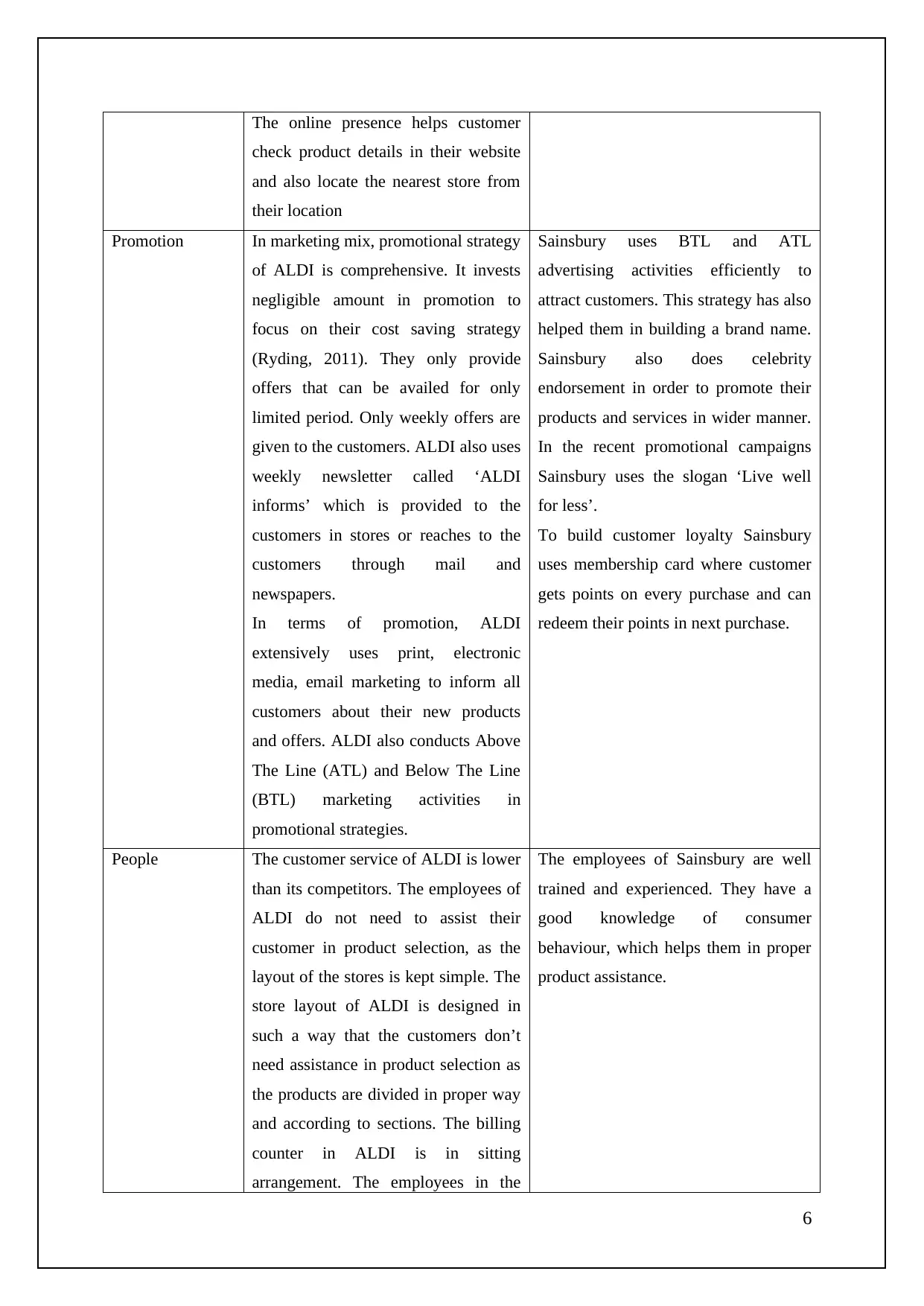
The online presence helps customer
check product details in their website
and also locate the nearest store from
their location
Promotion In marketing mix, promotional strategy
of ALDI is comprehensive. It invests
negligible amount in promotion to
focus on their cost saving strategy
(Ryding, 2011). They only provide
offers that can be availed for only
limited period. Only weekly offers are
given to the customers. ALDI also uses
weekly newsletter called ‘ALDI
informs’ which is provided to the
customers in stores or reaches to the
customers through mail and
newspapers.
In terms of promotion, ALDI
extensively uses print, electronic
media, email marketing to inform all
customers about their new products
and offers. ALDI also conducts Above
The Line (ATL) and Below The Line
(BTL) marketing activities in
promotional strategies.
Sainsbury uses BTL and ATL
advertising activities efficiently to
attract customers. This strategy has also
helped them in building a brand name.
Sainsbury also does celebrity
endorsement in order to promote their
products and services in wider manner.
In the recent promotional campaigns
Sainsbury uses the slogan ‘Live well
for less’.
To build customer loyalty Sainsbury
uses membership card where customer
gets points on every purchase and can
redeem their points in next purchase.
People The customer service of ALDI is lower
than its competitors. The employees of
ALDI do not need to assist their
customer in product selection, as the
layout of the stores is kept simple. The
store layout of ALDI is designed in
such a way that the customers don’t
need assistance in product selection as
the products are divided in proper way
and according to sections. The billing
counter in ALDI is in sitting
arrangement. The employees in the
The employees of Sainsbury are well
trained and experienced. They have a
good knowledge of consumer
behaviour, which helps them in proper
product assistance.
6
check product details in their website
and also locate the nearest store from
their location
Promotion In marketing mix, promotional strategy
of ALDI is comprehensive. It invests
negligible amount in promotion to
focus on their cost saving strategy
(Ryding, 2011). They only provide
offers that can be availed for only
limited period. Only weekly offers are
given to the customers. ALDI also uses
weekly newsletter called ‘ALDI
informs’ which is provided to the
customers in stores or reaches to the
customers through mail and
newspapers.
In terms of promotion, ALDI
extensively uses print, electronic
media, email marketing to inform all
customers about their new products
and offers. ALDI also conducts Above
The Line (ATL) and Below The Line
(BTL) marketing activities in
promotional strategies.
Sainsbury uses BTL and ATL
advertising activities efficiently to
attract customers. This strategy has also
helped them in building a brand name.
Sainsbury also does celebrity
endorsement in order to promote their
products and services in wider manner.
In the recent promotional campaigns
Sainsbury uses the slogan ‘Live well
for less’.
To build customer loyalty Sainsbury
uses membership card where customer
gets points on every purchase and can
redeem their points in next purchase.
People The customer service of ALDI is lower
than its competitors. The employees of
ALDI do not need to assist their
customer in product selection, as the
layout of the stores is kept simple. The
store layout of ALDI is designed in
such a way that the customers don’t
need assistance in product selection as
the products are divided in proper way
and according to sections. The billing
counter in ALDI is in sitting
arrangement. The employees in the
The employees of Sainsbury are well
trained and experienced. They have a
good knowledge of consumer
behaviour, which helps them in proper
product assistance.
6
⊘ This is a preview!⊘
Do you want full access?
Subscribe today to unlock all pages.

Trusted by 1+ million students worldwide
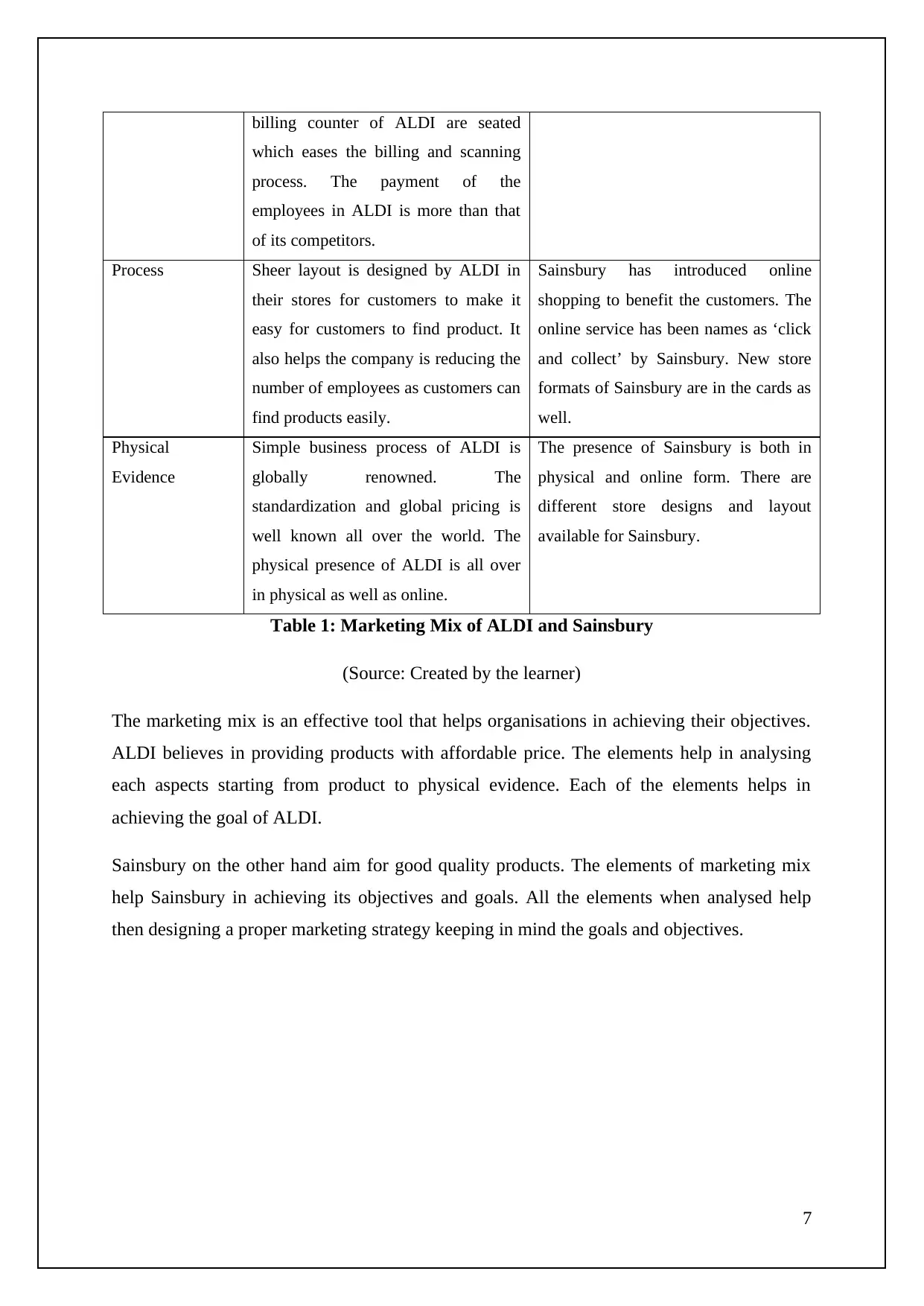
billing counter of ALDI are seated
which eases the billing and scanning
process. The payment of the
employees in ALDI is more than that
of its competitors.
Process Sheer layout is designed by ALDI in
their stores for customers to make it
easy for customers to find product. It
also helps the company is reducing the
number of employees as customers can
find products easily.
Sainsbury has introduced online
shopping to benefit the customers. The
online service has been names as ‘click
and collect’ by Sainsbury. New store
formats of Sainsbury are in the cards as
well.
Physical
Evidence
Simple business process of ALDI is
globally renowned. The
standardization and global pricing is
well known all over the world. The
physical presence of ALDI is all over
in physical as well as online.
The presence of Sainsbury is both in
physical and online form. There are
different store designs and layout
available for Sainsbury.
Table 1: Marketing Mix of ALDI and Sainsbury
(Source: Created by the learner)
The marketing mix is an effective tool that helps organisations in achieving their objectives.
ALDI believes in providing products with affordable price. The elements help in analysing
each aspects starting from product to physical evidence. Each of the elements helps in
achieving the goal of ALDI.
Sainsbury on the other hand aim for good quality products. The elements of marketing mix
help Sainsbury in achieving its objectives and goals. All the elements when analysed help
then designing a proper marketing strategy keeping in mind the goals and objectives.
7
which eases the billing and scanning
process. The payment of the
employees in ALDI is more than that
of its competitors.
Process Sheer layout is designed by ALDI in
their stores for customers to make it
easy for customers to find product. It
also helps the company is reducing the
number of employees as customers can
find products easily.
Sainsbury has introduced online
shopping to benefit the customers. The
online service has been names as ‘click
and collect’ by Sainsbury. New store
formats of Sainsbury are in the cards as
well.
Physical
Evidence
Simple business process of ALDI is
globally renowned. The
standardization and global pricing is
well known all over the world. The
physical presence of ALDI is all over
in physical as well as online.
The presence of Sainsbury is both in
physical and online form. There are
different store designs and layout
available for Sainsbury.
Table 1: Marketing Mix of ALDI and Sainsbury
(Source: Created by the learner)
The marketing mix is an effective tool that helps organisations in achieving their objectives.
ALDI believes in providing products with affordable price. The elements help in analysing
each aspects starting from product to physical evidence. Each of the elements helps in
achieving the goal of ALDI.
Sainsbury on the other hand aim for good quality products. The elements of marketing mix
help Sainsbury in achieving its objectives and goals. All the elements when analysed help
then designing a proper marketing strategy keeping in mind the goals and objectives.
7
Paraphrase This Document
Need a fresh take? Get an instant paraphrase of this document with our AI Paraphraser
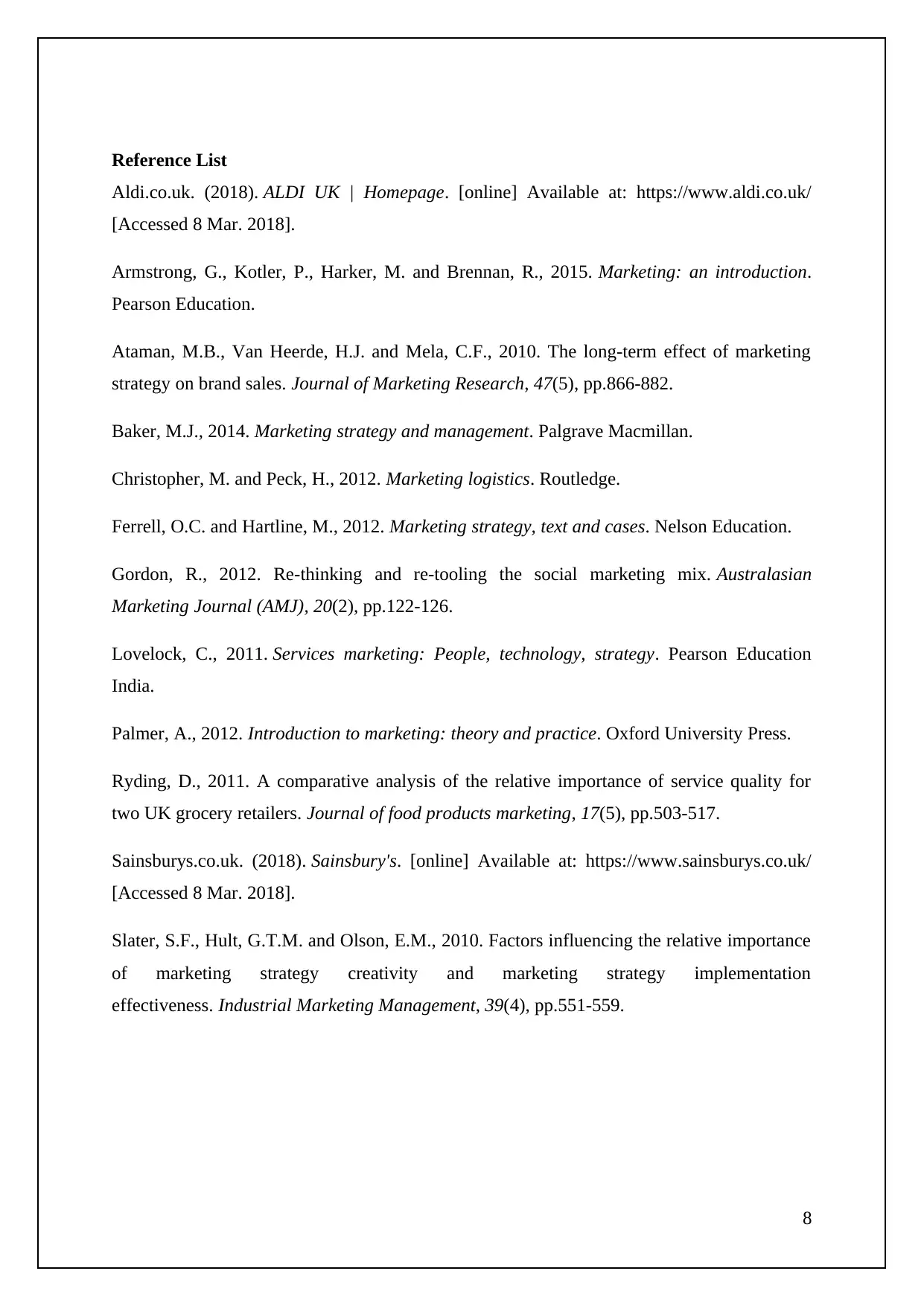
Reference List
Aldi.co.uk. (2018). ALDI UK | Homepage. [online] Available at: https://www.aldi.co.uk/
[Accessed 8 Mar. 2018].
Armstrong, G., Kotler, P., Harker, M. and Brennan, R., 2015. Marketing: an introduction.
Pearson Education.
Ataman, M.B., Van Heerde, H.J. and Mela, C.F., 2010. The long-term effect of marketing
strategy on brand sales. Journal of Marketing Research, 47(5), pp.866-882.
Baker, M.J., 2014. Marketing strategy and management. Palgrave Macmillan.
Christopher, M. and Peck, H., 2012. Marketing logistics. Routledge.
Ferrell, O.C. and Hartline, M., 2012. Marketing strategy, text and cases. Nelson Education.
Gordon, R., 2012. Re-thinking and re-tooling the social marketing mix. Australasian
Marketing Journal (AMJ), 20(2), pp.122-126.
Lovelock, C., 2011. Services marketing: People, technology, strategy. Pearson Education
India.
Palmer, A., 2012. Introduction to marketing: theory and practice. Oxford University Press.
Ryding, D., 2011. A comparative analysis of the relative importance of service quality for
two UK grocery retailers. Journal of food products marketing, 17(5), pp.503-517.
Sainsburys.co.uk. (2018). Sainsbury's. [online] Available at: https://www.sainsburys.co.uk/
[Accessed 8 Mar. 2018].
Slater, S.F., Hult, G.T.M. and Olson, E.M., 2010. Factors influencing the relative importance
of marketing strategy creativity and marketing strategy implementation
effectiveness. Industrial Marketing Management, 39(4), pp.551-559.
8
Aldi.co.uk. (2018). ALDI UK | Homepage. [online] Available at: https://www.aldi.co.uk/
[Accessed 8 Mar. 2018].
Armstrong, G., Kotler, P., Harker, M. and Brennan, R., 2015. Marketing: an introduction.
Pearson Education.
Ataman, M.B., Van Heerde, H.J. and Mela, C.F., 2010. The long-term effect of marketing
strategy on brand sales. Journal of Marketing Research, 47(5), pp.866-882.
Baker, M.J., 2014. Marketing strategy and management. Palgrave Macmillan.
Christopher, M. and Peck, H., 2012. Marketing logistics. Routledge.
Ferrell, O.C. and Hartline, M., 2012. Marketing strategy, text and cases. Nelson Education.
Gordon, R., 2012. Re-thinking and re-tooling the social marketing mix. Australasian
Marketing Journal (AMJ), 20(2), pp.122-126.
Lovelock, C., 2011. Services marketing: People, technology, strategy. Pearson Education
India.
Palmer, A., 2012. Introduction to marketing: theory and practice. Oxford University Press.
Ryding, D., 2011. A comparative analysis of the relative importance of service quality for
two UK grocery retailers. Journal of food products marketing, 17(5), pp.503-517.
Sainsburys.co.uk. (2018). Sainsbury's. [online] Available at: https://www.sainsburys.co.uk/
[Accessed 8 Mar. 2018].
Slater, S.F., Hult, G.T.M. and Olson, E.M., 2010. Factors influencing the relative importance
of marketing strategy creativity and marketing strategy implementation
effectiveness. Industrial Marketing Management, 39(4), pp.551-559.
8
1 out of 8
Related Documents
Your All-in-One AI-Powered Toolkit for Academic Success.
+13062052269
info@desklib.com
Available 24*7 on WhatsApp / Email
![[object Object]](/_next/static/media/star-bottom.7253800d.svg)
Unlock your academic potential
Copyright © 2020–2025 A2Z Services. All Rights Reserved. Developed and managed by ZUCOL.





